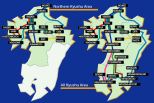Welcome to Kyushu!
Below, you will find a map of Kyushu. The 7 prefectures of Kyushu are labled as Fukuoka(福岡), Oita(大分), Kumamoto(熊本), Saga(佐賀), Kagoshima(鹿児島), Nagasaki(長崎) and Miyazaki(宮崎)
For more Japan traveling information, please visit :
http://www.japan-guide.com/e/e623b.html
For sample itineraries, please visit:
http://www.japan-guide.com/e/e2400.html
Population and Language
Most of Kyushu's population are concentrated along the northwest coast in the city of Fukuoka and Kitakyushu. Kyushu has a population of 13.320 million people which is 10.6% of Japan's total population.
It is difficult to communite with the locals in any other languages other than Japanese. Some hotel employees are able to communicate with the visitors in English, but only in those that cater to foreign tourists.
Transportation
The main transporation methods around Kysuhu are by train, taxi, private cars, buses, ferry and plane.
Kyushu Japan Railway
The Kyushu JR railroad has been sufficiently used in Kyushu, as the northern Sinkansen was opened in march 2011 while the southern Sinkansen was opened in 2004. This helps save travller's time on the train, as it only takes 33 minute to get to Kumamoto from Hakata when it use to take 1 hour and 13 minutes. Also, the Kyushu Railway Pass are available to those who are planning to stay in Kyushu for 3-5 days. This meant that visitors will not need to purchase other train tickets to get to their desire destination, instead, they could use the Kyushu Railway Pass to get to any destinations on the JR Kyushu Line.
The prices are provided below:
Northern Kyushu Area :
3 day pass 7000 Yen
All Kyushu Area:
3 day pass 14,000 yen
5 day pass 17,000 yen
Links:http://www.jrkyushu.co.jp/english/
http://www.jrpass.com/
Buses
Kyushu highway buses are available, and also bus centers are established in the 7 prefectures. Vistors can also book seats on line as time tables are available for them.
The following links will lead you to Across Kyushu highway bus reservation website:
http://www.rakubus.jp/english/etc/faq.html#sna_p
http://www.nishitetsu.co.jp/bus/highway/gb/
http://jik.nnr.co.jp/cgi-bin/Tschedule/menu.exe?pwd=gb/menu.pwd&mod=F&menu=F
Access to/from Fukuoka International Airport
Transportation methods including subway, shuttle bus to domestic and international terminal , taxi, parking information are provided below.
For more information please visit:
http://www.fuk-ab.co.jp/english/frame_index.html
Emergency Telephone numbers
Police: 110
Ambulance:119
Fire: 119
Phone Directory: 104
Postal Address
Addresses written in Japanese start with the postal code, followed by the prefecture, city and subarea(s), and end with the recipient's name.
Addresses written in English start with the recipient's name and end with the prefecture and postal code.
Geographical information
Japan consists of several thousand islands, of which Honsyu, Hokkaido, Kyushu and Shikoku are the main islands. Kyushu is located south of the main land and is the third largest island of Japan. Kyushu is also considered as the birth place of Japanese civilization. More than 50% of Kyushu is covered by forests and mountains. Japan is politically seperated into 8 regions and 47 prefectures.
Climate
Kyushu has a warmer and tropical climate than the main lands. In the summer, the temperature reaches a highest of 31 in Fukuoka while the raining season also occurs during Spring and Summer. In the winter, the nothern part of Kyushu tends to get colder than the southern part. The best time of the year to visit Kyushu is around May to September. Below is a reference climate chart of Fukuoka.
Feburary tends to be the best time to experience winter activities. Towards the end of March, visitors are able to watch cherry blossoms in some cities. April is the time of the year where cherry blossom is full in season. Next, in May Golden Week is one of Japan's busiest traveling season. June tends to be the rainy season except for Hokkaido, it continutes for the rest of June and ends in mid July. August is the month with the highest temperature as Fukuoka reaches 32 Celcius which the Typhoon season reaches its peak in August and September. Trees began to turn colors in October and in November , autumn leaf sight seeing spots are also a great experience for visitors. Ski season starts in December.
Please visit http://www.japan-guide.com/e/e2273.html
for more information on Kyushu climate.
Currency
The unit of currency in Japan is yen. Visitors can exchange your currency into yen at any bank or hotels.
The current currency exchange value between:
USD and JPY
1 USD = 93.3960 JPY
RMB and JPY
1 CNY = 14.9759 JPY
TWD and JPY
1 TWD = 3.16087 JPY
KRW and JPY
1 JPY=11.59 KRW
EUR and JPY
1.00 EUR=127.219 JPY
Japanese yen comes in coins and bills.
Coins comes in with, 1, 5, 10, 50 , 100 and 500 yen
Bills comes in with 1000, 2000, 5000, and 10000 yen. However, 2000 yen bills are very rare.
Vending machines in Kyushu accept 5, 10, 50, 100 and 500 yen coins.
For more currency exchange information, please visit
http://www.xe.com/
For more information on Japan currency, please visit
http://www.japan-guide.com/e/e2196.html
ATM's
Japanese ATM's allow users to withdraw, deposit and transfer money by credit and debit cards issued outside of Japan, including Visa, Plus, Mastercard, Maestro, Cirrus, American Express and JCB cards , ATM's also provides an English user menu.
ATM's at 7-Eleven stores are available for 24 hours, however these ATM's are unavailable on Sundays for four hours betwen 20:00 and midnight.
Electricity
The voltage in Japan is 100 Volt, which is different from North America (120V), Central Europe (220V). Japanese power outlets are identical to ungrounded North American outlets. The frequency of electric current is 60 Hertz in Kyushu.








